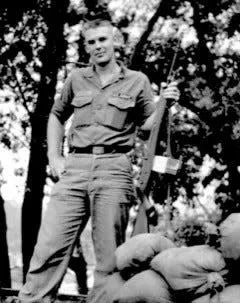The Courier Journal
I served in Vietnam, no child should experience the horror of military weapons as I did
Editor’s note: this story details historic violence and connects it to the recent massacre in Uvalde, Texas, which some readers may find upsetting.
We are again in another horrible, tragic moment. Our school children were murdered by a gunman with an assault rifle.
On this Memorial Day, it brings it all back for me to a place I do not want to go. Even though I was awarded a Bronze Star while there, some of it is still very painful. But for all of us who love this nation, we feel we must stand up and be counted.
In Vietnam, I carried an M-16 and I was assigned to the 7th Psychological Operations Battalion in Da Nang, South Vietnam. We made propaganda leaflets and dropped them from airplanes. Hoping they would persuade the enemy to surrender.
After battles, our soldiers assembled enemy bodies for a body count. I was assigned to photograph them for new leaflets, describing the battle and their friend’s death. Nothing was more shocking than to see the results of arms and legs blown off or bodies cut in half. Close-up views of what assault weapons were meant to do. Kill people.

Therefore, I understand why DNA had to be provided for some of the small children in Texas. I’ve seen and photographed the results of assault weapons.
When I thought back about how the horrors of war, what I saw in Vietnam and that same thing had happened to our young children in school, it became too much. Life, liberty and the pursuit of happiness is what we go to wars over. The protection of our family and nation is what it’s all about.
I cannot remain silent when I see our, so-called leaders, put more importance on guns than they do the safety of our people.
Fifty Republican senators are responsible for nothing being done on gun control, or restrictions on assault weapons in the U.S. I suggest those senators be required to go to the morgue in Texas and see, firsthand, what their love for power and weapons has accomplished and then explain to us why it is more important than the lives of our school children.
More: Texas shooting raises pressure on Mitch McConnell to pass gun laws. Why it will likely fail
Why are these 50 republicans so adamant about protecting the unborn, from fertilization to delivery? But after birth, do nothing to protect them from gunmen who murder them in schools? They only deliver lip service. Statements, that we as parents can recite, word for word. “Need more teachers with guns,” or “more funds for mental health.” Your actions speak loud and clear and your words are totally meaningless.
Senators, you should see in person, what your precious handy work and stalling tactics have achieved. To see small children – cut beyond recognition. If that doesn’t affect your opinion nothing will. I know that will never happen because that takes courage, integrity, and responsibility and you have none.
Our only solution is to seek out those politicians responsible for this problem and vote them out of office. As voters, this should be our number one priority on the ballot. Stop the killing of our children. Then your replacement can work and help make laws that will help keep our citizens from being killed.

This is not about taking away your guns — it always comes to that argument — no one wants to take away your guns. It’s only about removing military-style weapons from the public that should never have been there in the first place. If this had been done by a terrorist attack on our school children – something would have been done immediately.
Wes Kendall is an artist, Vietnam Veteran and Bronze Star recipient who lives in Louisville.










